The Elder Futhark runes are more than just ancient symbols; they are the whispers of the past, echoing the profound spirituality and the vibrant culture of the Norse and Germanic ancestors. These runes, integral to Norse mythology, served not only as a means of communication but also as a conduit for the mystical and the divine, deeply interwoven with the everyday lives of the Viking and Germanic peoples.
The allure of these ancient characters lies in their dual role as both a practical alphabet and a system imbued with magical and symbolic meanings, reflecting the rich tapestry of life during the Viking Age.
Translating these ancient symbols into modern English is no mere academic exercise; it’s a journey into the heart of a civilization that viewed the world through a lens vastly different from our own. The challenge lies not only in the translation but in capturing the essence and the nuanced meanings that each rune represents.
For enthusiasts of Norse mythology and paganism, understanding Elder Futhark is a gateway to a deeper connection with the ancient wisdom and traditions of the Norse. As we delve into the world of runes, we embark on a path of discovery, unearthing the secrets of a bygone era and bringing its wisdom into our modern lives.
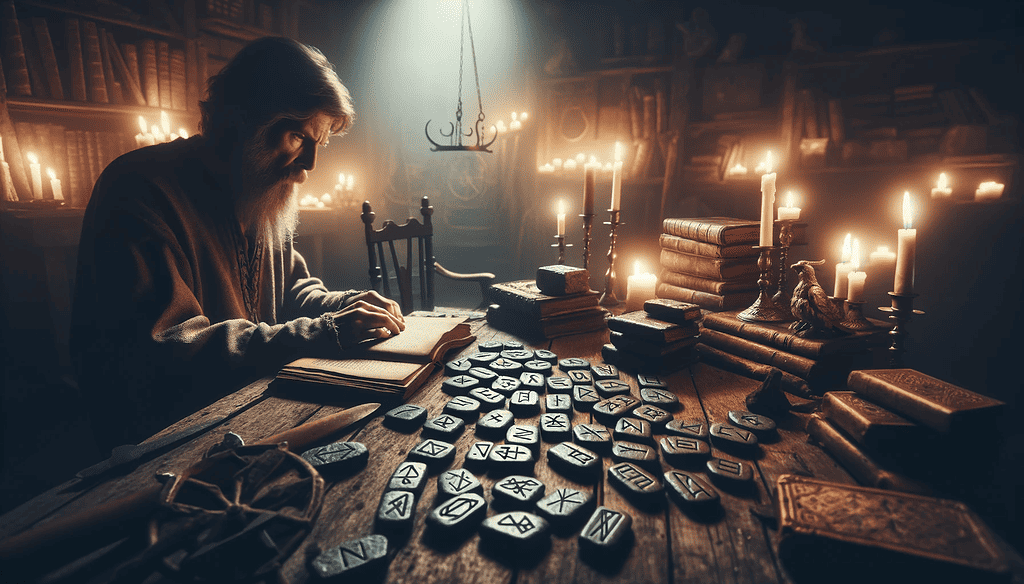
Table of Contents
The Elder Futhark Runes: An Overview
Origins and History
The Elder Futhark, named after the first six runes (F, U, Þ, A, R, K), represents the oldest form of the runic alphabets. Its roots can be traced back to the 2nd century, a time when the ancient Germanic tribes roamed freely, long before the Viking Age reshaped the landscape of Northern Europe.
These characters, etched in stone, metal, and wood, served as the primary script for the early Germanic peoples, encapsulating their experiences, beliefs, and the world around them. The transition of these runes across centuries, from simple inscriptions to complex texts, mirrors the evolution of the societies that used them, offering a tangible link to our shared past.
Runic Philosophy and Magical Purposes
To the modern observer, runes might appear as mere symbols. However, to those steeped in Norse mythology and the ancient traditions of Norse paganism, they are far more profound. Each rune was believed to hold its unique power, a distinct vibration that resonated with the natural and supernatural worlds. This connection imbued the runes with a role far beyond conventional writing; they were tools for divination, protective talismans, and focal points for magical rites.
In rituals, each rune was invoked for its specific energies, weaving a tapestry of intention and invocation that linked the practitioner to the ancient forces they sought to channel. This mystical dimension of the runic characters highlights their significance not just as a form of communication, but as a bridge to the divine, a means through which the ancient Norse sought to understand and influence the world around them.
In this way, the Elder Futhark runes serve as a window into the spiritual landscape of our ancestors, offering insights into a worldview where every letter was laden with meaning, every inscription a spell.
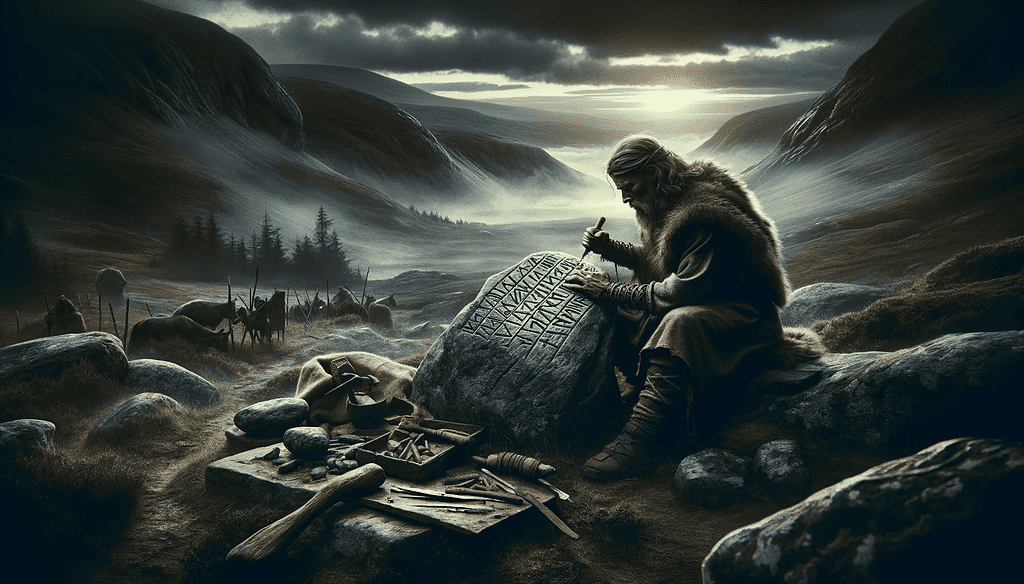
The Phonetic Nature of Runes
Understanding the Phonetic System
The Elder Futhark runes are fundamentally phonetic in nature, each symbol representing a specific sound rather than a letter as we understand in modern English or the Latin alphabet. This phonetic system reflects the oral traditions of the ancient Germanic peoples, where the sound of the spoken word held primacy over the written form.
In this context, runes were more than just letters; they were echoes of the spoken language, intricately tied to the Germanic peoples’ auditory perception of their world. This distinction is crucial for enthusiasts of Norse mythology and paganism, as it emphasizes the need to approach runic writing and translation with an ear for phonetics, understanding that each rune encapsulates a sound integral to the ancient languages of the Norse.
Challenges with Modern Translations
In the digital age, online rune converters promise easy translation from English to runes and vice versa. However, these tools often fall short, as they typically operate on a letter-for-letter replacement system, neglecting the phonetic essence of runic writing. This approach overlooks the nuances of ancient pronunciation and the context-dependent nature of runic inscriptions, leading to translations that might be technically correct but lack authenticity and depth.
For true aficionados of Norse culture and paganism, recognizing these limitations is essential. Accurate translation requires a deep understanding of the phonetic system of the Elder Futhark and an appreciation for the historical and cultural context in which these runes were used. It’s a journey back in time, to an era where the sound of a word held magic and the act of writing was a sacred ritual, connecting the rune writer with the ancient energies of Norse mythology.
Deciphering Runes: A Beginner’s Guide
Basic Principles of Runic Translation
Embarking on the journey of runic translation is akin to learning a new language, one that speaks not just through letters but through the very essence of sound and context. For beginners, the key lies in embracing the phonetic nature of the Elder Futhark runes, understanding that each symbol represents a sound or a group of sounds rather than a direct counterpart to modern English letters.
This approach requires a shift in perspective, from seeing runes as mere characters to viewing them as expressions of ancient voices, each sound a piece of the puzzle in the vast tapestry of Norse culture and mythology.
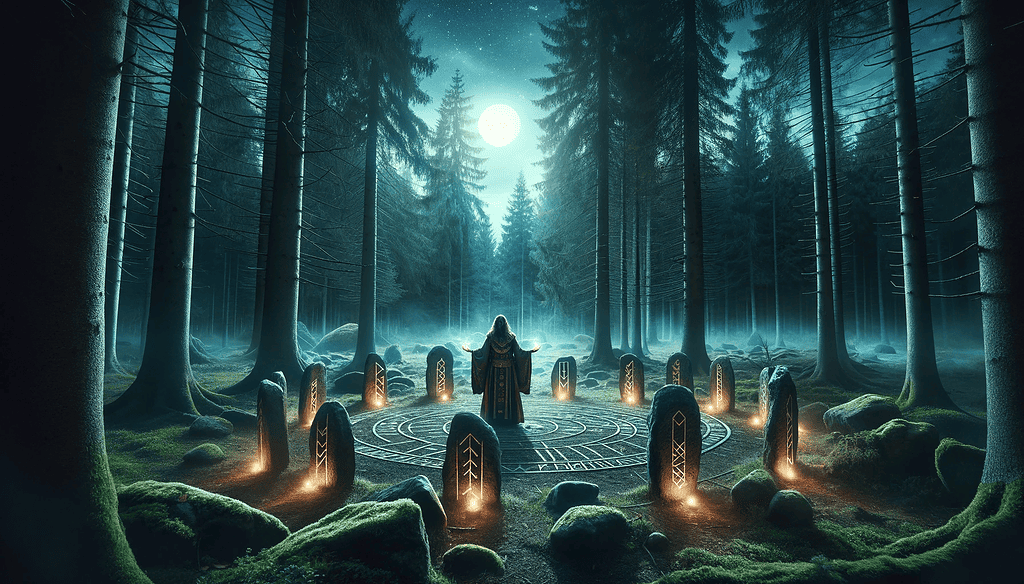
The Runes and Their Meanings
Delving into the meanings of the Elder Futhark runes is an adventure into the heart of Norse wisdom. Each rune, with its unique shape and sound, carries the weight of centuries, embodying specific aspects of life, nature, and the divine as perceived by the ancient Germanic and Norse peoples.
For instance, Fehu, the first rune, is not just the ‘F’ sound; it encapsulates wealth, prosperity, and the dynamic energy of creation. Similarly, Uruz, representing strength and vitality, evokes the raw power of a wild ox. Through these symbols, beginners can start to unlock the layers of meaning and insight that the runes offer, each one a portal to understanding the values, struggles, and aspirations of our ancestors.
| Rune | Symbol | Phonetic Value | Pronunciation | Meaning |
|---|---|---|---|---|
| Fehu | ᚠ | f | /ˈfeːhu/ (feh-hoo) | Wealth, prosperity, new beginnings |
| Uruz | ᚢ | u (oo) | /ˈuːruz/ (oo-rooz) | Strength, health, wild nature |
| Thurisaz | ᚦ | th | /ˈθuriˌsaz/ (thoo-ree-saz) | Giant, protection, defensive force |
| Ansuz | ᚨ | a | /ˈɑnsuz/ (ahns-ooz) | God, communication, wisdom |
| Raidho | ᚱ | r (rolled) | /ˈrɑiðo/ (rye-tho) | Journey, movement, rhythm |
| Kenaz | ᚲ | k (hard) | /ˈkenɑz/ (ken-ahz) | Torch, knowledge, creativity |
| Gebo | ᚷ | g (hard) | /ˈɡebo/ (geh-bo) | Gift, partnership, exchange |
| Wunjo | ᚹ | w | /ˈwunjɔ/ (woon-yo) | Joy, pleasure, harmony |
| Hagalaz | ᚺ | h | /ˈhɑɡɑlɑz/ (hah-gah-lahz) | Hail, disruption, radical change |
| Nauthiz | ᚾ | n | /ˈnɑuθiz/ (now-theez) | Need, constraint, survival |
| Isa | ᛁ | i (ee) | /ˈisɑ/ (ee-sah) | Ice, stagnation, clarity |
| Jera | ᛃ | j (y) | /ˈjɛrɑ/ (yehr-ah) | Harvest, reward, cycles |
| Eihwaz | ᛇ | ei (long i) | /ˈeiwɑz/ (eye-wahz) | Yew tree, endurance, initiation |
| Perthro | ᛈ | p | /ˈpɛrθro/ (per-thro) | Mystery, fate, chance |
| Algiz | ᛉ | z/ʀ (vibrant) | /ˈɑlɡiz/ (ahl-geez) | Protection, elk, sanctuary |
| Sowilo | ᛊ | s | /ˈsoːwilo/ (soh-wee-loh) | Sun, success, solace |
| Tiwaz | ᛏ | t | /ˈtiːwɑz/ (tee-wahz) | Justice, leadership, victory |
| Berkano | ᛒ | b | /ˈbɛrkɑno/ (berk-ah-no) | Birth, renewal, growth |
| Ehwaz | ᛖ | e (eh) | /ˈɛhwɑz/ (eh-wahz) | Horse, trust, movement |
| Mannaz | ᛗ | m | /ˈmɑnnɑz/ (mahn-nahz) | Humanity, self, community |
| Laguz | ᛚ | l | /ˈlɑɡuz/ (lah-gooz) | Water, intuition, renewal |
| Ingwaz | ᛜ | ŋ (ng) | /ˈiŋwɑz/ (ing-wahz) | Earth, fertility, the god Ing |
| Dagaz | ᛞ | d | /ˈdɑɡɑz/ (dah-gahz) | Day, awakening, breakthrough |
| Othala | ᛟ | o (long o) | /ˈoːθɑlɑ/ (oh-thah-lah) | Heritage, inheritance, home |
CLICK HERE TO LEARN HOW TO READ AND WRITE IN ELDER FUTHARK RUNES
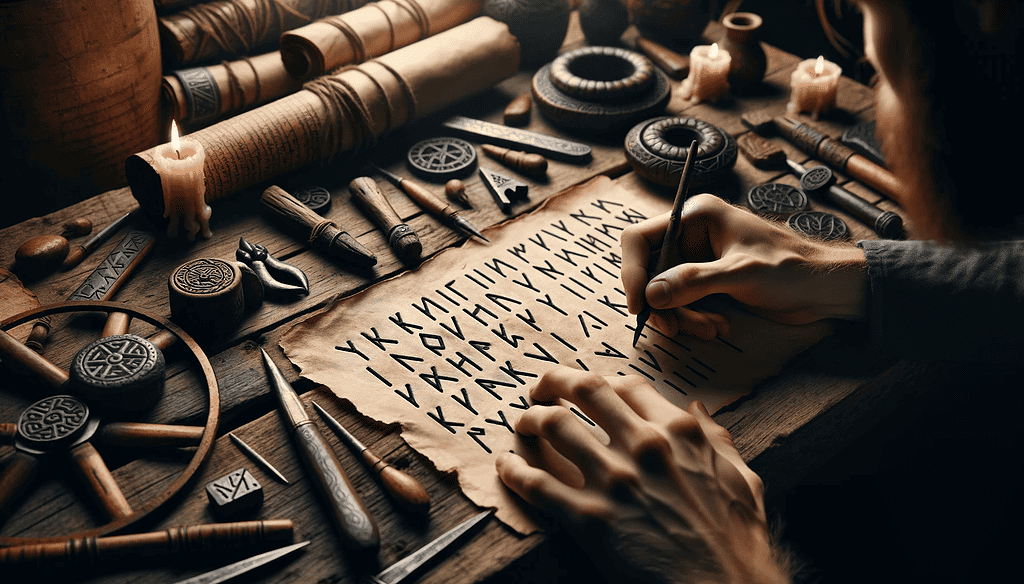
Engaging with runes goes beyond mere translation; it’s an invitation to connect with the ancient world, to see through the eyes of the Viking and Germanic peoples who carved these symbols with reverence and purpose.
As you explore each rune, consider not just its sound but its story, the myriad ways it might have been used in daily life, in magic, and in the sacred rituals of the Norse. This holistic approach opens up a new dimension of understanding, one where every rune becomes a key to unlocking the mysteries of a bygone era.
🌟 Unlock the Secrets of the Runes with My Rune Phonetic Flashcards! 🌟
Delve deeper into the mystical realm of Norse mythology with my exclusive Rune Phonetic Flashcards! Perfect for beginners and enthusiasts, these cards provide a practical way to master the phonetic transcription of Elder Futhark runes.
Practical Application: Writing in Runes
From English to Elder Futhark: A Step-by-Step Approach
For enthusiasts of Norse mythology and paganism eager to bridge the ancient with the modern, writing English phrases in Elder Futhark runes can be a rewarding endeavor. The key is to prioritize phonetic accuracy over direct letter substitution.
Start by breaking down your English phrase into its basic sounds, paying close attention to the vowels and consonants as they would have sounded in the context of ancient Germanic languages.
Then, match these sounds to their closest runic equivalents, keeping in mind that some runes represent more than one sound and some English sounds may not have a direct runic counterpart. This phonetic approach ensures that your runic inscriptions resonate with the authentic spirit of Norse tradition.
Common Pitfalls and How to Avoid Them
A common mistake among beginners is relying too heavily on modern rune converters, which often lead to inaccuracies by oversimplifying the complex relationship between runes and sounds. Another frequent error is the direct letter-for-letter translation, which disregards the phonetic essence of the Elder Futhark system.
To avoid these pitfalls, immerse yourself in the study of Old Norse phonetics and the historical contexts in which runes were used. Practice by writing simple words and gradually move to more complex phrases, cross-referencing with authentic runic texts whenever possible.
Remember, the goal is not just to transcribe but to connect with an ancient form of expression, so approach each rune with respect for its historical and cultural significance. This mindful approach will enrich your practice and bring you closer to the ancient wisdom encoded in the runes.
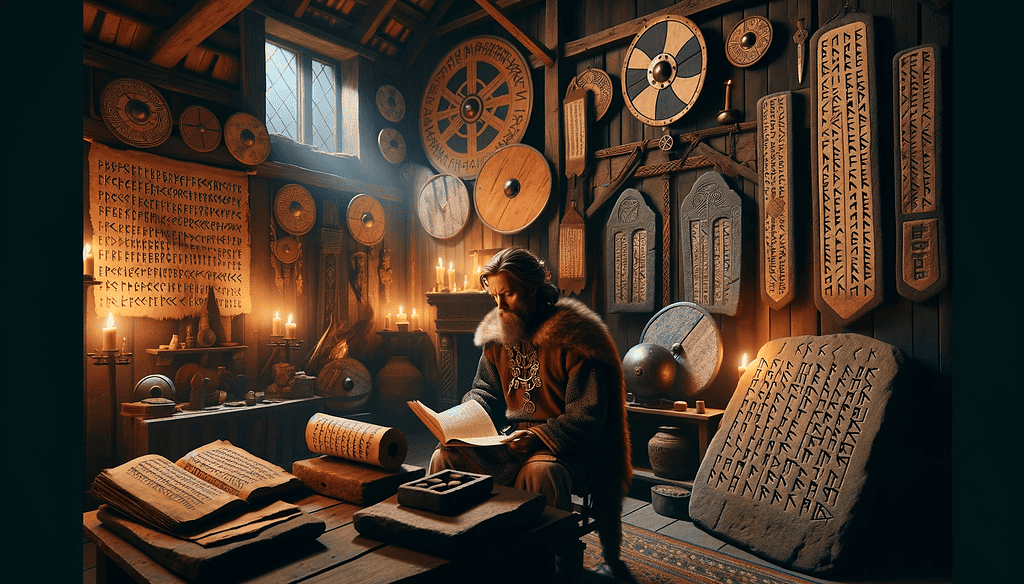
Beyond the Basics: Deepening Your Runic Practice
Incorporating Runes into Daily Life
For those who feel a deep connection to Norse heritage, integrating runic characters into daily life can be a meaningful way to honor this ancient tradition. Consider personal inscriptions on jewelry or clothing, using runes to represent significant concepts or qualities you wish to embody.
Home decor, too, can be enriched with runic symbols, from wall art to carved furniture, each piece a conversation starter and a reminder of the rich tapestry of Norse mythology. Even simple practices like journaling or meditation can incorporate runes, using them as focal points for reflection or as themes for personal growth. By weaving these symbols into the fabric of everyday life, enthusiasts create a living link to the wisdom and valor of the Norse.
Advanced Runic Studies: Old Norse Language and Lore
To truly grasp the depth of runic tradition, delving into the study of Old Norse language and lore is invaluable. This journey might begin with the younger Futhark, exploring its evolution from the Elder Futhark and its adaptation to the changing linguistic landscape of the Viking Age.
Engaging with Old Norse texts, such as the Poetic Edda or sagas, provides context to the runes, illuminating their use in literature, inscriptions, and even everyday communication. Visiting museums or historical sites, either physically or through virtual tours, can bring enthusiasts face-to-face with runic inscriptions on artifacts, offering a tangible connection to the past.
Such immersive studies not only deepen one’s understanding of the runes but also foster a greater appreciation for the rich cultural and spiritual world of the Norse people. Through this dedicated exploration, the runes become more than symbols; they are gateways to the heart of Norse heritage.
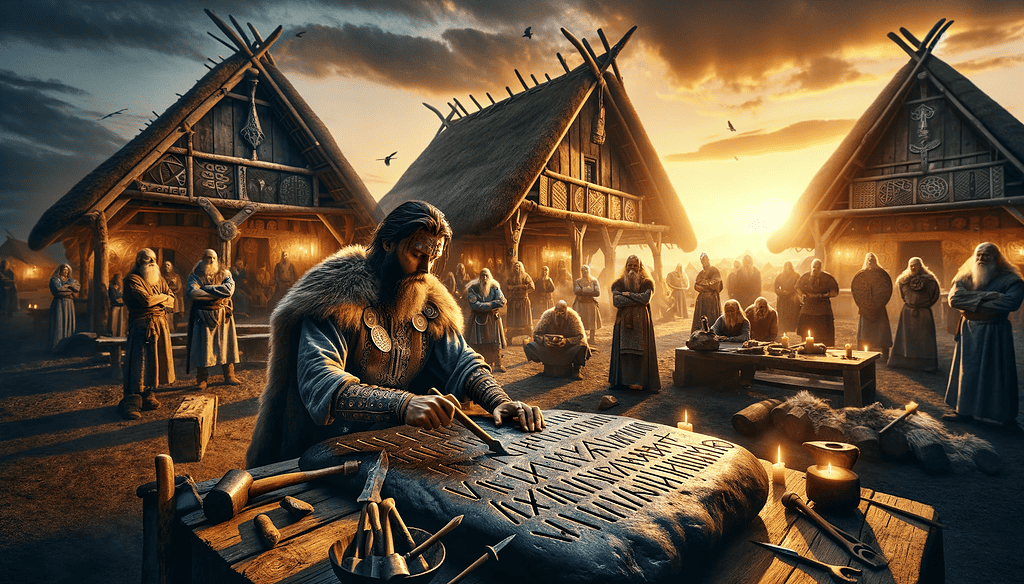
The Evolution of Runic Alphabets: From Elder to Younger Futhark
The Elder Futhark: Origins and Significance
The Elder Futhark, revered as the oldest form of the runic alphabet, is pivotal in the study of ancient scripts. It encompasses 24 symbols that were integral to the linguistic and cultural practices of early Germanic peoples. These runes transcended mere written communication, serving multifaceted roles in commerce, warfare, rituals, and magical practices, and are found in inscriptions across Europe, from Scandinavia to the expanses inhabited by Germanic tribes.
Transition to the Younger Futhark
The linguistic landscape of the Germanic world underwent significant transformations, culminating in the evolution from the Elder to the Younger Futhark around the Viking Age. This newer alphabet, comprising 16 runes, mirrored the phonetic shifts in Scandinavian languages, streamlining the writing system to better align with spoken language. This condensation meant individual runes came to represent multiple sounds, adding complexity to the runic texts and their interpretation.
Creating a comprehensive table for all the runes in the Elder Futhark, Younger Futhark, and Anglo-Saxon Futhorc would be extensive due to the number of characters and the detail involved. Given the space and formatting limitations here, I’ll provide a condensed version that captures the essence of each runic alphabet. For a full exploration, each rune set could be presented in its dedicated section with more detailed descriptions.
Comprehensive Rune Comparison Table
| Elder Futhark Rune | Phonetic Value | Younger Futhark Rune | Phonetic Value | Anglo-Saxon Futhorc Rune | Phonetic Value |
|---|---|---|---|---|---|
| Fehu (ᚠ) | f | Fé (ᚠ) | f | Feoh (ᚠ) | f |
| Uruz (ᚢ) | u | Úr (ᚢ) | u | Ur (ᚢ) | u |
| Thurisaz (ᚦ) | th | Þurs (ᚦ) | th | Thorn (ᚦ) | th |
| Ansuz (ᚨ) | a | Áss (ᚬ) | a | Os (ᚩ) | o/a |
| Raidho (ᚱ) | r | Reið (ᚱ) | r | Rad (ᚱ) | r |
| Kenaz (ᚲ) | k | Kaun (ᚴ) | k | Cen (ᚳ) | k |
| Gebo (ᚷ) | g | * | Gyfu (ᚷ) | g | |
| Wunjo (ᚹ) | w | * | Wynn (ᚹ) | w | |
| Hagalaz (ᚺ) | h | Hagall (ᚼ) | h | Haegl (ᚻ) | h |
| Nauthiz (ᚾ) | n | Nauðr (ᚾ) | n | Nyd (ᚾ) | n |
| Isa (ᛁ) | i | Íss (ᛁ) | i | Is (ᛁ) | i |
| Jera (ᛃ) | j/y | *Ar (ᛅ) | æ | Ger (ᛄ) | j/y |
| Eihwaz (ᛇ) | ei | Ýr (ᛦ) | y | Eoh (ᛇ) | eo |
| *Perthro (ᛈ) | p | * | Peorth (ᛈ) | p | |
| Algiz (ᛉ) | z | * | Eolh (ᛉ) | x | |
| Sowilo (ᛊ) | s | Sól (ᛋ) | s | Sigel (ᛋ) | s |
| Tiwaz (ᛏ) | t | Týr (ᛏ) | t | Tiw (ᛏ) | t |
| Berkano (ᛒ) | b | Bjarkan (ᛒ) | b | Beorc (ᛒ) | b |
| Ehwaz (ᛖ) | e | Ehwaz (ᛖ) | e | Eh (ᛖ) | e |
| Mannaz (ᛗ) | m | Maðr (ᛘ) | m | Mann (ᛗ) | m |
| Laguz (ᛚ) | l | Lögr (ᛚ) | l | Lagu (ᛚ) | l |
| Ingwaz (ᛜ) | ng | *Ing (ᛜ) | ng | Ing (ᛝ) | ng |
| Dagaz (ᛞ) | d | Dagr (ᛞ) | d | Daeg (ᛞ) | d |
| Othala (ᛟ) | o | Othal (ᛟ) | o | Ethel (ᛟ) | o |
| * | * |
In the table, the asterisk (*) is used to denote a few different situations regarding the runes across the Elder Futhark, Younger Futhark, and Anglo-Saxon Futhorc:
- No Direct Equivalent: When an asterisk is placed next to a rune’s name or in the cell under a specific runic alphabet, it indicates that there is no direct equivalent for that rune in the given runic alphabet. For example, some runes present in the Elder Futhark do not have a corresponding rune in the Younger Futhark due to its reduced size and scope. Similarly, certain runes in the Anglo-Saxon Futhorc do not have counterparts in the Elder or Younger Futhark.
- Unique Runes: The asterisk might also highlight runes that are unique to a specific runic alphabet and do not appear in the others. The Anglo-Saxon Futhorc, for example, expanded to include additional runes that are not found in the Elder or Younger Futhark, catering to sounds specific to the Old English language.
- General Note: In some cases, the asterisk can be used as a general notation to signal that further information or specific exceptions apply to the rune or its usage. This could pertain to variations in phonetic value, usage, or historical context that are not fully captured within the table’s simplified format.
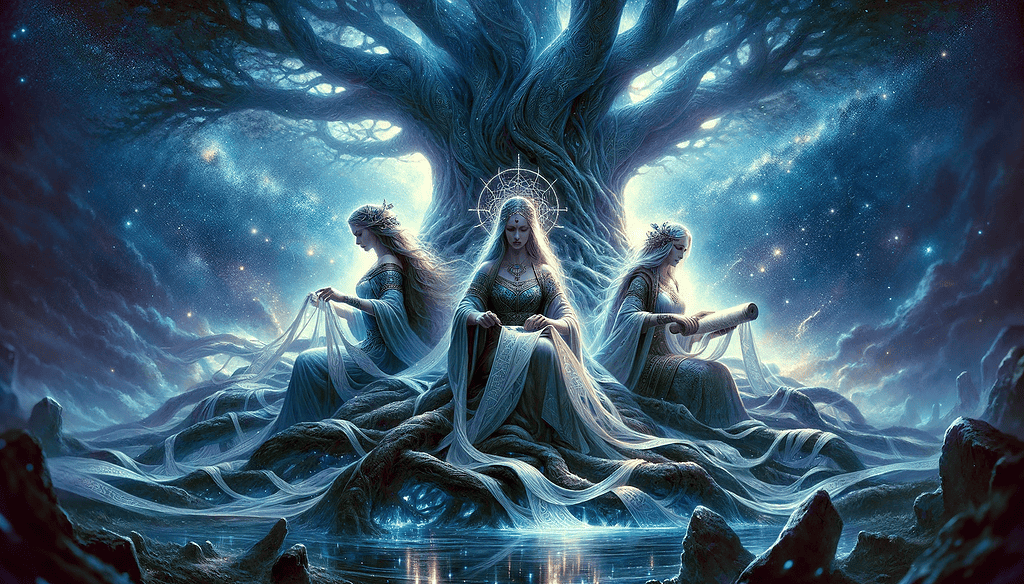
Challenges with Runic Translators
The task of translating these ancient scripts is fraught with challenges, particularly due to the non-phonetic approach employed by many modern runic translators. These translators often rely on direct visual transcriptions, using the English alphabet as a reference point, rather than drawing from the phonetic nuances of the Germanic languages. This method can lead to inaccuracies, as it overlooks the complex sound representations inherent in the runes and the subtleties of their historical and linguistic contexts.
Navigating Historical Context for Accurate Interpretation
For those engaged in the study of runes, understanding the transition between futharks is crucial, but so is recognizing the limitations of contemporary rune translation methods. Accurate interpretation demands a deep dive into the phonetic structures of ancient Germanic languages and an appreciation for the historical contexts in which these scripts were used. It’s a reminder of the dynamic nature of language and script, reflecting the societal shifts that influenced ancient communication and expression.
This exploration into the evolution of runic alphabets not only connects us with the Norse and Germanic ancestors but also highlights the importance of methodical and contextually aware approaches to unraveling the mysteries of ancient scripts.
FAQ: Delving into the Runic Realms
What is a runic translator and how accurate are they?
Runic translators are tools or individuals specializing in converting runic text into modern languages or vice versa. However, accuracy can be compromised since many translators use a direct letter-for-letter approach, relying on the English alphabet, which doesn’t account for the phonetic depth of runic systems. True translation requires a nuanced understanding of the original Germanic languages.
Can you explain the meaning of the runic language?
The runic language is not just a system of writing but a compilation of symbols each bearing its unique meaning, often intertwined with Norse mythology and the values of the Germanic people. The runes convey messages about life, nature, the divine, and more, making them a profound historical set of characters with rich semantic layers.
How does a runic generator work?
A runic generator typically converts modern English text into runic symbols based on predetermined algorithms. However, this “easy way” often overlooks the phonetic intricacies and cultural contexts of the runes, leading to a lack of authenticity in the translated text.
What’s the difference between the Elder and Older Futhark?
The Elder Futhark, often referred to as the “older” Futhark, is the earliest runic alphabet, used from the 2nd to 8th centuries. It consists of 24 runes. The term “Older Futhark” is just another way to refer to the Elder Futhark, emphasizing its status as the original runic system.
What is the significance of Old Norse in runic translations?
Old Norse, the language of the Viking Age Scandinavians and their ancestors, is crucial for accurate runic translations, especially when dealing with runic inscriptions from this period. An old Norse translator who understands the linguistic nuances can provide more accurate renditions of runic text, as they’re familiar with the specific dialects and idiomatic expressions of the time.
How are runes used in modern text editors and fonts?
In modern text editors, runes may appear as special characters or fonts designed to mimic the runic alphabets for aesthetic or educational purposes. While this allows for the incorporation of runic symbols into English text, it often lacks the historical and phonetic accuracy of traditional runic writing.
What role does Nordic mythology play in understanding runes?
Nordic mythology is intertwined with runic symbols, with many runes directly reflecting mythological themes and deities. Understanding these myths can enrich one’s interpretation of runic inscriptions, revealing deeper layers of meaning beyond the immediate phonetic or alphabetic value.
Can runes be considered a dead language?
While the specific runic writing systems like the Elder and Younger Futhark are no longer used as living languages, the cultural and historical significance of runes remains alive in the study of ancient texts, Norse mythology, and modern pagan practices. Runes are more than a linguistic system; they are a bridge to the past, carrying the wisdom and traditions of the northern Germanic tribes.
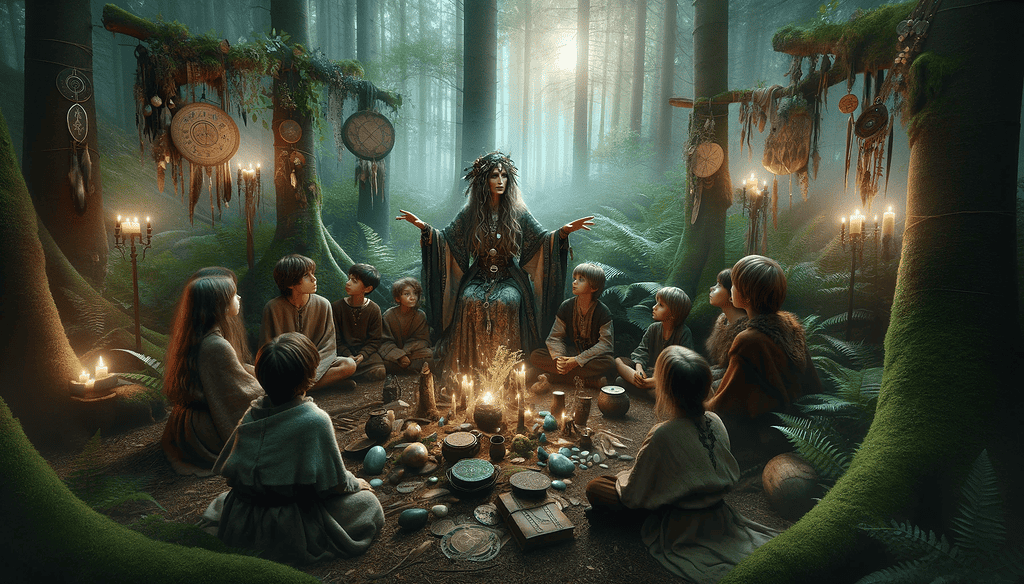
Final Thoughts
In the journey through the enigmatic world of Elder Futhark runes, we tread on sacred ground, touching the heart of Norse heritage and the wisdom of ancient Germanic peoples. Approaching these ancient symbols demands a deep reverence for their historical and cultural roots, recognizing that each rune is a vessel of both sound and spirit, intertwined with the fabric of Norse mythology.
For enthusiasts of paganism and Norse lore, the call to delve deeper into runic practices is not just about deciphering symbols; it’s an invitation to connect with a rich ancestral past and carry forward the legacy of the Vikings through informed understanding and respectful practice. The path of runic exploration is endless, filled with mysteries to unravel and insights to gain, beckoning those who hear the call to continue their quest for knowledge in the realms of the ancient North.
Check out these other categories:
